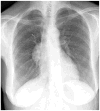Thymoma and immunodeficiency (Good syndrome): a report of 2 unusual cases and review of the literature
- PMID: 17304889
- PMCID: PMC3102047
- DOI: 10.1016/S1081-1206(10)60695-3
Thymoma and immunodeficiency (Good syndrome): a report of 2 unusual cases and review of the literature
Abstract
Background: Good syndrome is a rare cause of combined B- and T-cell immunodeficiency that occurs in association with a thymoma. Patients affected with Good syndrome have increased susceptibility to bacterial, fungal, viral, and opportunistic infections.
Objective: To describe 2 unusual cases of infections in patients with Good syndrome and review the literature.
Methods: Case 1 describes a 51-year-old woman with Good syndrome who presented with a 10-day history of diarrhea, nausea, and fevers. During her hospitalization she became pancytopenic and underwent a bone marrow biopsy and evaluation of her peripheral blood smear. Case 2 describes an 89-year-old man with Good syndrome who presented with a nonhealing leg ulcer, which underwent biopsy. A literature search through MEDLINE was performed. Keywords included Good syndrome, thymoma, hypogammaglobulinemia, immunodeficiency, and infection.
Results: The peripheral blood smear in patient 1 showed ring-formed parasites in red blood cells suggestive of babesiosis. She began treatment with azithromycin, atovaquone, and doxycycline and recovered completely. Patient 2 underwent a biopsy of the foot. Immunohistochemical staining was positive for human herpesvirus 8 consistent with Kaposi sarcoma.
Conclusions: The concomitant occurrence of immunodeficiency and thymoma is known as Good syndrome. In contrast to other humoral immune defects, patients with this syndrome can develop opportunistic infections, and the prognosis appears less favorable compared with X-linked agammaglobulinemia or common variable immunodeficiency. Immunological investigations, including T-cell subsets, B cells, and quantitative immunoglobulins, should be considered part of the routine diagnostic evaluation in patients with a thymoma and recurrent infections.
Figures



Similar articles
-
Severe T- and B-cell immune deficiency associated with malignant thymoma.Ann Allergy Asthma Immunol. 2003 Nov;91(5):501-5. doi: 10.1016/S1081-1206(10)61522-0. Ann Allergy Asthma Immunol. 2003. PMID: 14692437
-
Durable hypogammaglobulinemia associated with thymoma (Good syndrome).Intern Med. 2009;48(19):1749-52. doi: 10.2169/internalmedicine.48.2375. Epub 2009 Oct 1. Intern Med. 2009. PMID: 19797831
-
Precursor B-cell development in bone marrow of Good syndrome patients.Clin Immunol. 2019 Mar;200:39-42. doi: 10.1016/j.clim.2018.11.009. Epub 2019 Jan 25. Clin Immunol. 2019. PMID: 30690192
-
Infections in patients with immunodeficiency with thymoma (Good syndrome). Report of 5 cases and review of the literature.Medicine (Baltimore). 2001 Mar;80(2):123-33. doi: 10.1097/00005792-200103000-00005. Medicine (Baltimore). 2001. PMID: 11307588 Review.
-
[Thymoma with immunodeficiency/Good syndrome associated with myasthenia gravis].Rinsho Shinkeigaku. 2017 May 27;57(5):208-213. doi: 10.5692/clinicalneurol.cn-000984. Epub 2017 Apr 27. Rinsho Shinkeigaku. 2017. PMID: 28450687 Review. Japanese.
Cited by
-
Common variable immunodeficiency: etiological and treatment issues.Int Arch Allergy Immunol. 2009;150(4):311-24. doi: 10.1159/000226232. Epub 2009 Jul 1. Int Arch Allergy Immunol. 2009. PMID: 19571563 Free PMC article. Review.
-
A Bad Case of Good's Syndrome.Infect Dis Ther. 2014 Dec;3(2):333-7. doi: 10.1007/s40121-014-0045-7. Epub 2014 Oct 7. Infect Dis Ther. 2014. PMID: 25287948 Free PMC article.
-
Good's Syndrome Patients Hospitalized for Infections: A Single-Center Retrospective Study.Medicine (Baltimore). 2015 Nov;94(47):e2090. doi: 10.1097/MD.0000000000002090. Medicine (Baltimore). 2015. PMID: 26632723 Free PMC article.
-
Long COVID-19 leading to Good's syndrome diagnosis: A clinical case-report and literature review.Clin Case Rep. 2024 May 27;12(6):e8962. doi: 10.1002/ccr3.8962. eCollection 2024 Jun. Clin Case Rep. 2024. PMID: 38808198 Free PMC article.
-
A Case Report of Good's Syndrome Diagnosed After Thymomectomy.Cureus. 2025 Jun 8;17(6):e85545. doi: 10.7759/cureus.85545. eCollection 2025 Jun. Cureus. 2025. PMID: 40630374 Free PMC article.
References
-
- Tarr PE, Sneller MC, Mechanic LJ, et al. Infections in patients with immunodeficiency with thymoma (Good syndrome): report of 5 cases and review of the literature. Medicine. 2001;80:123–133. - PubMed
-
- Good RA, Varco RL. A clinical and experimental study of agammaglobulinemia. J Lancet. 1955;75:245–271. - PubMed
-
- Bonilla FA, Bernstein IL, Khan DA, et al. Practice parameter for the diagnosis and management of primary immunodeficiency. Ann Allergy Asthma Immunol. 2005;94(5 suppl 1):S1–63. - PubMed
-
- Souadjian JV, Enriquez P, Silverstein MN, et al. The spectrum of diseases associated with thymoma: coincidence or syndrome. Arch Intern Med. 1974;134:374–379. - PubMed
-
- Rosenow EC, Hurley BT. Disorders of the thymus: a review. Arch Intern Med. 1984;144:763–772. - PubMed
Publication types
MeSH terms
Substances
Grants and funding
LinkOut - more resources
Full Text Sources
Medical

